Is your Samsung fridge leaving a watery mess behind? Discover the culprit behind the water leakage from your ice maker. Don’t let the inconvenience dampen your kitchen experience.
In this article, we’ll unravel the mystery of a leaking ice maker in Samsung fridges.
Get ready to troubleshoot the issue, learn preventive maintenance tips, and explore different ice maker designs.
Bid farewell to the waterworks and keep your fridge running smoothly. Let’s dive in!
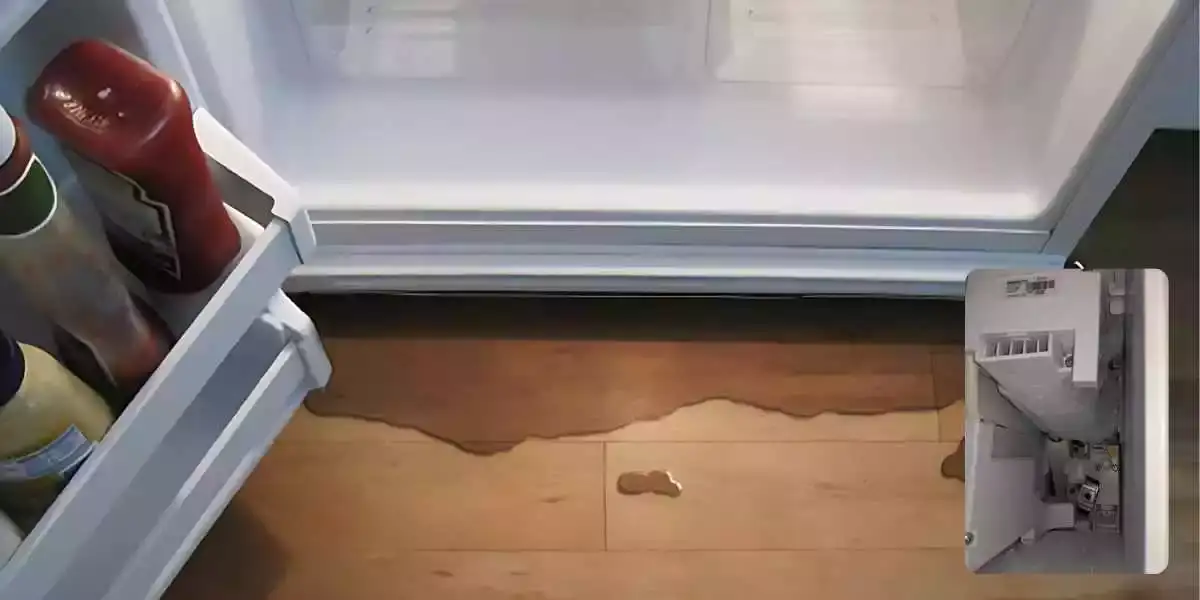
Why is the Samsung fridge leaking water from the ice maker?
If your Samsung fridge is leaking water from the ice maker, there may be a problem with the ice maker assembly, water inlet valve, or clogged water line.
Check for any visible leaks, ensure proper water flow, and consider contacting a professional for repair.
Common Causes of Water Leakage from the Ice Maker
By addressing these common causes, you can take the necessary steps to fix the water leakage from your Samsung fridge’s ice maker:
1. Faulty Water Inlet Valve:
When the water inlet valve is faulty, it fails to shut off completely, leading to water overflow and subsequent leakage.
To address this issue, you should first locate the water inlet valve, usually situated at the back of the fridge.
Inspect the valve for any signs of damage, such as cracks or leaks. If necessary, replace the valve to restore proper functioning.
2. Defective Ice Maker Assembly:
A damaged or worn-out ice maker assembly can be a common culprit behind water leakage.
Examine the assembly closely for any visible cracks, misalignments, or other signs of damage.
If you notice any issues, consider replacing the assembly to resolve the leakage problem effectively.
3. Clogged Water Line:
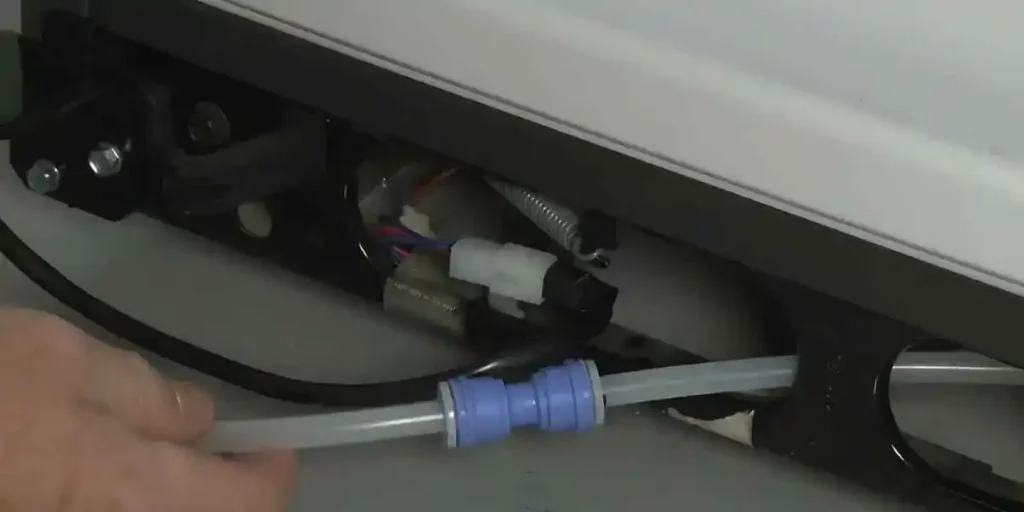
A clogged water line can disrupt the smooth flow of water to the ice maker, resulting in leakage.
Begin by disconnecting the fridge from the power source. Locate the water line, usually found at the back of the fridge or inside the freezer.
Carefully inspect the line for any obstructions, such as ice buildup or debris. If there are any blockages, clear them gently using a soft cloth or warm water.
4. Improper Leveling:
If your fridge is not leveled correctly, water can accumulate and leak from the ice maker.
Start by checking the fridge’s positioning using a bubble level. Adjust the fridge’s legs or use shims to achieve proper leveling.
Ensure that the fridge is stable and balanced on all sides to prevent water leakage.
5. Excessive Water Pressure:
High water pressure can overwhelm the ice maker, causing it to leak. Check the water pressure entering your home’s plumbing system.
If it exceeds the recommended range (typically 20-120 psi), you’ll need to install a pressure regulator.
A pressure regulator will help maintain optimal water pressure, preventing leakage issues.
Potential Risks of a Leaking Ice Maker in Your Samsung Fridge
A leaking ice maker in your Samsung fridge can lead to various risks and complications.
It’s important to address the issue promptly to prevent further damage. Here are some potential risks associated with a leaking ice maker:
1. Water Damage:
When water leaks from the ice maker, it can seep into the surrounding areas, including the fridge’s interior and nearby cabinets.
This can result in water damage, leading to stains, warping, and deterioration of surfaces.
Prolonged exposure to moisture can also promote the growth of mold and mildew, posing health risks.
2. Electrical Hazards:
Water leakage near electrical components can create electrical hazards. If the water comes into contact with exposed wires or electrical connections, it can cause short circuits, malfunctions, or even electrical shocks. This poses a serious safety concern and requires immediate attention.
3. Freezer Compartment Issues:
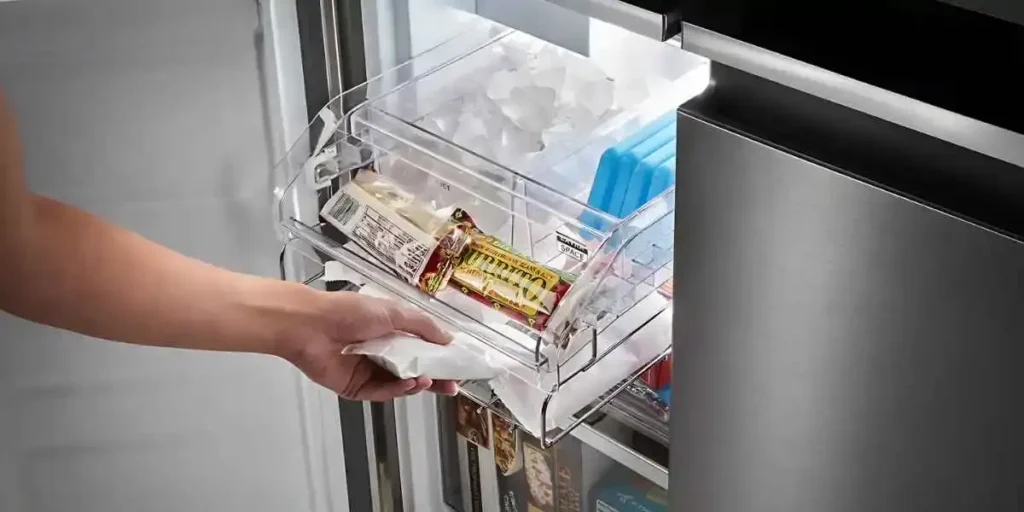
A leaking ice maker can cause water to accumulate in the freezer compartment. This can lead to the formation of ice buildup, hindering the proper closing and sealing of the freezer door.
As a result, the freezer’s efficiency may be compromised, leading to increased energy consumption and potential food spoilage.
4. Ice Quality and Taste:
Water leakage from the ice maker can contaminate the ice cubes, affecting their quality and taste.
The presence of impurities or improper water flow can result in discolored or foul-tasting ice.
This can be particularly concerning if you use ice for beverages or food preparation.
5. Decreased Lifespan of Components:
Continuous water leakage can cause corrosion and damage to various components of the ice maker and surrounding areas.
This can lead to premature wear and tear, reducing the overall lifespan of these parts.
Repair or replacement of affected components may be necessary, incurring additional expenses.
Troubleshooting Steps for Fixing a Leaking Ice Maker
By following these troubleshooting steps, you can effectively address a leaking ice maker in your Samsung fridge:
1. Check for Proper Water Line Connections:
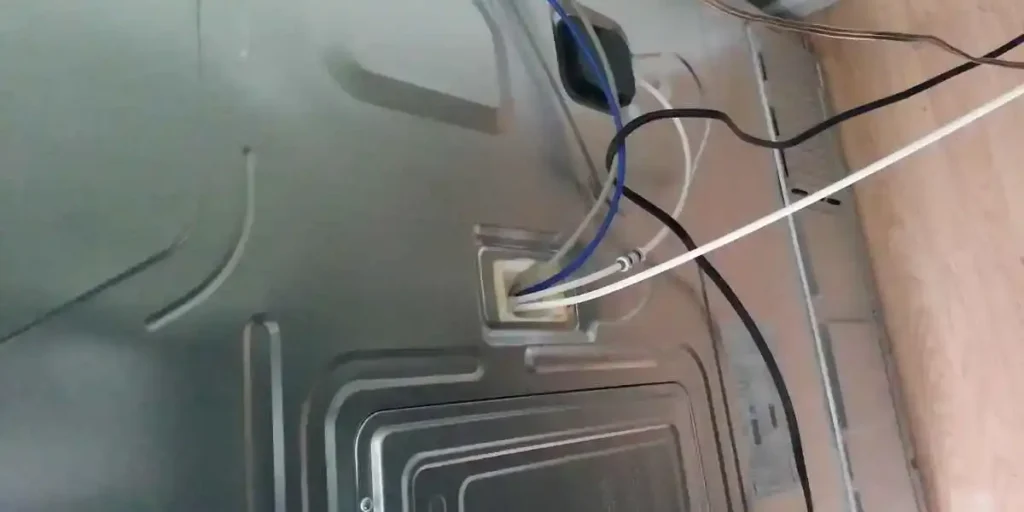
Start by ensuring that the water line connected to your Samsung fridge’s ice maker is securely attached.
Inspect the fittings and connections for any looseness or leaks. Tighten any loose connections or replace damaged components.
2. Examine the Water Inlet Valve:
Inspect the water inlet valve, located at the back of the fridge, for any signs of leaks or damage.
Turn off the water supply to the fridge and carefully examine the valve. If you notice any cracks, leaks, or blockages, replace the valve to restore proper water flow.
3. Clear Blockages in the Water Line:
If the water line is clogged, it can impede the flow of water to the ice maker, leading to leakage.
Disconnect the water line from the fridge and check for any obstructions, such as ice buildup or debris. Clear any blockages using a soft cloth or warm water.
4. Adjust the Fill Tube:
The fill tube delivers water to the ice maker. Ensure that it is properly aligned and inserted into the ice maker unit.
If misaligned, gently adjust the position of the fill tube to prevent water from spilling or overflowing.
5. Inspect the Ice Maker Assembly:
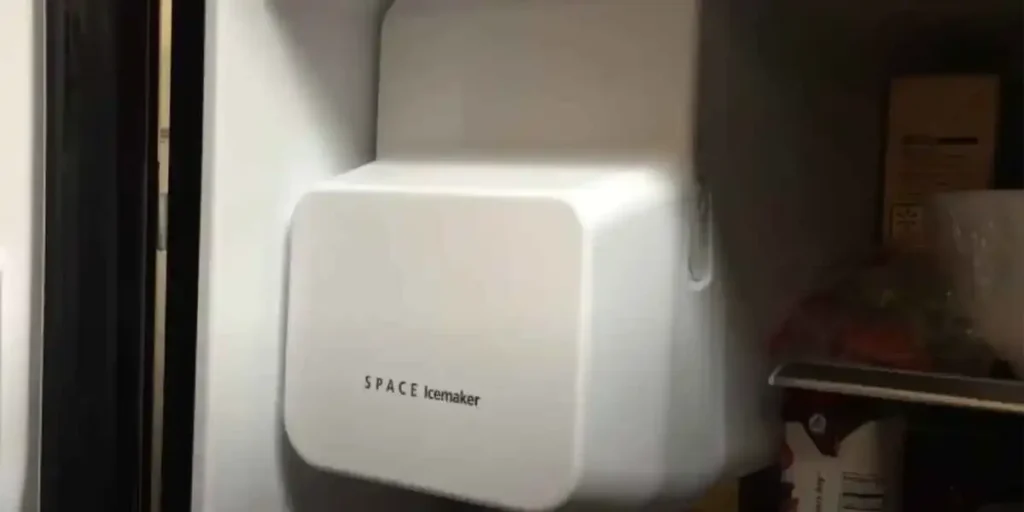
Carefully examine the ice maker assembly for any cracks, misalignments, or damaged components.
If you identify any issues, consider replacing the assembly to address the leakage problem effectively.
6. Test the Water Inlet Valve:
To determine if the water inlet valve is functioning correctly, use a multimeter to test its continuity.
Follow the manufacturer’s instructions and compare the readings with the specified range. If the readings are outside the normal range, replace the water inlet valve.
7. Verify Proper Leveling:
Check if your fridge is properly leveled. Use a bubble level to ensure that it is balanced on all sides.
Adjust the fridge’s legs or use shims to achieve proper leveling. A balanced fridge helps prevent water accumulation and subsequent leakage.
8. Seek Professional Assistance:
If the troubleshooting steps above do not resolve the issue, it is recommended to seek professional assistance.
A certified technician with expertise in Samsung fridges can diagnose the problem accurately and provide appropriate solutions.
Preventive Maintenance Tips for Your Samsung Fridge’s Ice Maker
Following these preventive maintenance tips, you can keep your Samsung fridge’s ice maker in optimal condition:
1. Regularly Clean the Ice Maker:
To prevent potential issues, clean your Samsung fridge’s ice maker regularly. Begin by disconnecting the power supply to the fridge. Remove the ice bin and wash it with mild detergent and warm water.
Thoroughly rinse and dry the bin before placing it back in the fridge. This helps prevent any buildup of dirt, debris, or mold that could affect the ice maker’s performance.
2. Check and Replace Water Filters:
Your Samsung fridge may have a water filter that helps maintain the quality of the ice and water.
Consult the user manual to locate the water filter and follow the manufacturer’s guidelines for replacement.
Typically, filters should be replaced every six months or as recommended by the manufacturer to ensure optimal performance and prevent clogging.
3. Inspect the Water Line:
Periodically examine the water line connected to the ice maker. Look for any signs of wear, kinks, or leaks.
If you notice any damage, replace the water line promptly to prevent water leakage or disruption in water flow.
4. Maintain Proper Temperature Settings:

Maintain the appropriate temperature settings in your fridge to ensure the ice maker functions optimally.
The recommended temperature for the freezer compartment is typically between 0 to 5 degrees Fahrenheit (-18 to -15 degrees Celsius).
Use a refrigerator thermometer to monitor and adjust the temperature accordingly.
5. Avoid Overfilling the Ice Bin:
Avoid overfilling the ice bin to prevent ice cubes from getting stuck and causing potential blockages.
Leave some space for the ice to freely fall into the bin. This helps maintain proper ice production and prevents strain on the ice maker’s mechanisms.
6. Clean the Freezer and Surrounding Area:
Regularly clean the freezer compartment and the surrounding areas of the ice maker.
Remove any food debris, spills, or ice buildup. Use a mixture of warm water and mild detergent to wipe down the interior surfaces.
This helps maintain a clean environment and prevents any contaminants from affecting the ice maker’s performance.
Comparing Different Ice Maker Designs for Samsung Fridges
Among these different ice maker designs, you can choose the Samsung fridge model that best suits your needs and preferences:
1. Traditional Ice Maker:
The traditional ice maker design for Samsung fridges features a basic mechanism. It consists of a water inlet valve, a fill tube, and a rotating tray with individual ice cube molds.
When the ice cubes are ready, the tray rotates, causing the cubes to fall into the ice bin below.
This design is simple, reliable, and widely used in many Samsung fridge models.
2. Dual Ice Maker:
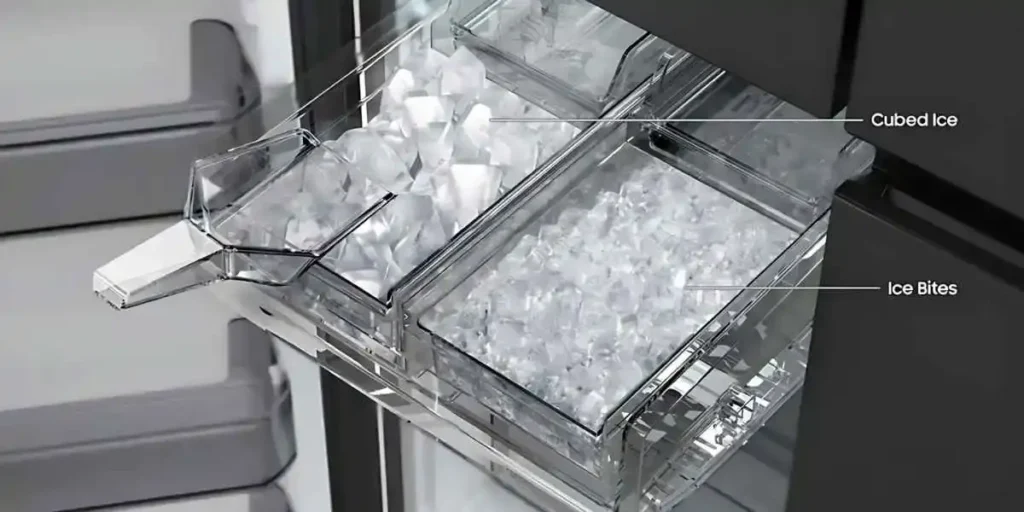
Some Samsung fridges offer a dual ice maker design, which includes an additional ice maker located in the freezer compartment.
This design provides the convenience of having a higher ice production capacity. With two ice makers, you can enjoy more ice cubes for parties or larger households.
The dual ice maker design is particularly beneficial for those who frequently require large quantities of ice.
3. Compact Ice Maker:
Samsung fridges with compact ice maker design feature a streamlined and space-saving approach. These ice makers are usually located in the door or inside the freezer compartment.
Despite their smaller size, they are still capable of producing a sufficient amount of ice cubes.
The compact design is ideal for those with limited freezer space or who prefer a sleek and minimalist fridge appearance.
4. Automatic Ice and Water Dispenser:
Certain Samsung fridge models incorporate an automatic ice and water dispenser. This design allows you to easily access both ice cubes and chilled water without opening the fridge door.
Simply press a button or use a touchpad to dispense ice or water directly into your glass.
The automatic dispenser design offers convenience and reduces the need to open the fridge frequently, helping to maintain internal temperature consistency.
5. Built-in Filtered Ice Maker:
Samsung fridges with a built-in filtered ice maker design provide an additional layer of ice quality assurance.
These ice makers are equipped with water filters that remove impurities, such as sediment and chlorine before the water enters the ice maker.
This ensures that the ice cubes produced are clean and fresh-tasting. The built-in filter helps enhance the overall ice quality and eliminates the need for separate ice cube trays.
FAQs
1. Can I Fix The Issue Myself Or Do I Need Professional Help?
You can attempt troubleshooting and fixing minor issues yourself, but for complex problems or if you’re unsure, it’s recommended to seek professional assistance.
2. Is There A Way To Prevent Water Leakage From The Ice Maker In My Samsung Fridge?
Yes, regular maintenance, such as cleaning the ice maker, checking water filters, and ensuring proper leveling, can help prevent water leakage issues.
3. What Are The Potential Risks Of A Leaking Ice Maker In A Samsung Fridge?
Risks may include water damage to surrounding areas, electrical hazards, freezer compartment issues, compromised ice quality and taste, and decreased component lifespan.
4. How Often Should I Clean My Samsung Fridge’s Ice Maker?
Cleaning the ice maker every few months or as needed is a good practice to maintain optimal performance and prevent issues.
5. When Should I Consider Replacing The Ice Maker In My Samsung Fridge?
If troubleshooting steps don’t resolve the issue, or if the ice maker assembly is significantly damaged, it may be necessary to replace it. Consult a professional for guidance.
Conclusion
Don’t let a leaking ice maker dampen your kitchen experience. By understanding the common causes and taking preventive maintenance measures, you can keep your Samsung fridge running smoothly.
Regularly check the water line, clean the ice maker, and ensure proper leveling. If issues persist, seek professional help to address the problem effectively.
Keep your fridge ice maker in top shape and bid farewell to water leakage worries.

